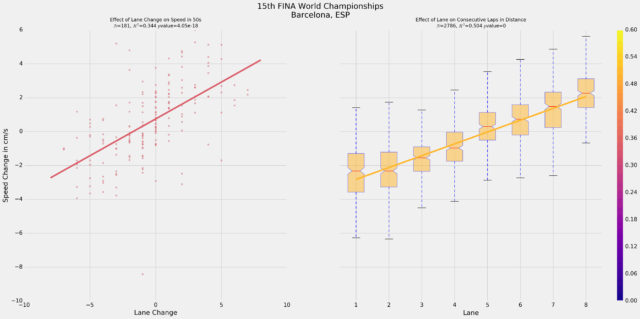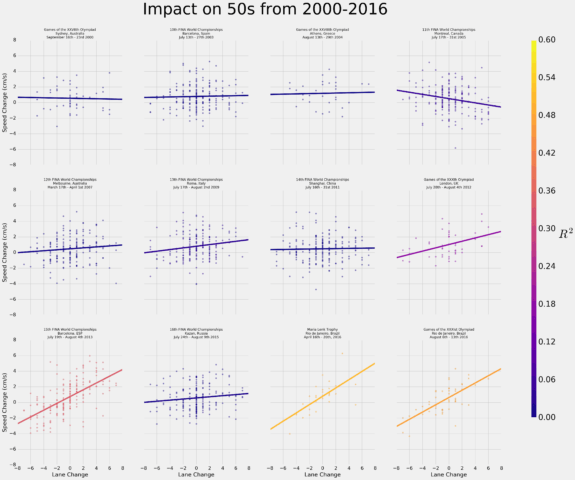Written by Barry Revzin: a few weeks ago Barry shared an article with SwimSwam on whether the pool in Rio had a current or not. His article along with the data got not only a lot of attention, but also a lot questions. Here, Barry answers those and goes in depth with even more data.
There were a few important questions that came up as a response to my initial article: Could the data be explained by effects specific to individual swimmers? Is this actually a common phenomenon across swimming competitions as a whole? If the effect is pool-specific, could the temporary pools have a greater potential impact than permanent pools?
After having widened my data set from the initial 5 meets to now include all the OmegaTiming results stretching back to 2000, the results are undeniable. The vast majority of meets in the sample show no effect of a current whatsoever. This is not a swimmer-specific phenomenon. Furthermore, analysis of another meet swum in the same pool as the Rio Olympics a few months earlier (the Maria Lenk Trophy), showed equally strong results with a nearly identical slope as the Rio Olympics data. When only a few meets show a strong effect, and those few include the pair swum in the same pool, this is clearly indicative of the pool causing the effect, not the swimmers themselves.
For each meet, I’ve considered the same two questions as I had in the previous article: (1) Was there an effect on a swimmer’s 50 time (including the 50 strokes where possible) based on how many lanes he or she shifted from heats to semifinals or finals? (2) Was there an effect on the change in consecutive 50 splits in the distance freestyle events based on the lane the swimmer was in? In both cases, I looked at the change in speed in cm/second. Previously, I looked at the percent change in time, but I think that speed change is the more direct change to look at. That’s what a current would do, were it to exist. There were several very large outliers in the set (as an example Annie Chandler swam a 26.63 in prelims in the 2012 Swimvitational but a 31.36 in finals), so I excluded any speed change that was larger in magnitude than 20cm/second (which is the difference between swimming a 50 free in 22.00 and 24.12).
For example, in the World Championships in Barcelona in 2013, those two effects were very strong:

Whereas, in the World Championships in Shanghai in 2011, those effects were absent:

Putting it together, here are effects I see in the 50s in all of the World Championships and Olympics that I have results for going back to Sydney in 2000. Each plot also includes the best fit line that shows the effect of changing lane on the swimmer’s speed in the next round:

Most of these meets show little-to-no effect of lane change. As you would expect. There are only three that do: Barcelona 2013, Rio 2016, and the Maria Lenk Trophy 2016. The Rio and Maria Lenk meets, swum in the same pool, have nearly identical results!
Let’s go even broader. Of the 180 meets in my data set, only four had effects that are significant, which I’m defining as having an R^2 (the percentage of change in speed that can be explained by lane change) above 20% and a pvalue (the probability of seeing this data given that there is no current) below 0.1%. Those four are:
| Meet | # points | Slope of Best-fit Line | R^2 | pvalue | Temporary? |
| 2016 Maria Lenk Trophy | 32 | 0.531 | 0.508 | 4.66E-06 | Yes |
| 2016 Olympics | 48 | 0.465 | 0.468 | 8.37E-08 | Yes |
| 2015 World Cup (Dubai) | 63 | 0.603 | 0.435 | 4.15E-09 | |
| 2013 World Championships | 181 | 0.435 | 0.344 | 4.05E-18 | Yes |
On the other hand, 115 events had R^2 values below 2%, which is no measurable effect.
A similar distribution can be seen when looking at the consecutive laps in distance events. There, only five meets satisfied having an R^2 above 20% and a pvalue below 0.1%:
| Meet | # points | Slope of Best-fit Line | R^2 | pvalue | Temporary? |
| 2016 Maria Lenk Trophy | 826 | 0.886 | 0.595 | 8.01E-164 | Yes |
| 2013 World Championships | 2786 | 0.699 | 0.504 | 0 | Yes |
| 2016 Olympics | 2004 | 0.504 | 0.374 | 6.36E-206 | Yes |
| 2012 Swimvitational | 1212 | -0.603 | 0.347 | 3.90E-114 | Yes |
| 2006 Pan Pacs | 1531 | 0.424 | 0.265 | 3.05E-104 |
whereas 159 had R^2 values above 2%.
Given how rare such effects are in the dataset, I think it’s safe to exclude the possibility that either swimmer-specific effects or generally common effects cause this behavior.
The construction of the pool itself may have an effect. In the dataset, there are a total of seven meets swum in temporary pools: the Maria Lenk Trophy, US Olympic Trials and Olympics in 2016, the World Championships in 2013 and 2015, and the Swimvitational and Olympic Trials in 2012. Of those 7, three show strong effects (the aforementioned Maria Lenk, Rio Olympics, and Barcelona World Championships), two show weak effects (the 2012 Swimvitational and Olympic Trials, both swum in the same pool), and two show no effects. On the other hand, only two permanent pools showed effects (the 2015 World Cup in Dubai and the 2006 Pan Pacs in Victoria). There isn’t a lot of data to go on here, but the simple fact that most pools showing effects are temporary and most temporary pools show an effect is, at least, noteworthy.
FINA’s statement that “[comments] are exclusively made on the basis of mathematical analysis, without taking into account any scientific evidence in the actual pool constructed for these Games” is true. All I’m presenting here is analysis of data available to me, and neither this analysis nor my previous article constitute proof of either the existence of a current or of any mechanical effects of temporary pools. But the likelihood of seeing these data without some sort of external effect is vanishingly small. While the analysis cannot prove the existence of a problem, it is pointing very, very strongly in that direction.
APPENDIX
This article is courtesy of and written by Barry Revzin.

How come you were unable to get Beijing Olympics results in your data set ?
I’d still love to have the complete data, but I’ve been able to scrape some of it from the official results book. So far, I’ve only got the 200m times. Maybe more to come. http://math.slu.edu/~clair/stat3850/data/RioSwim.csv
Barry, Thanks for the analysis! Where can we find the OmegaTiming results that you used in your analysis?
Re. “A mysterious force seemed to be interfering with the competition.” Washington Post.
I believe this swimming mystery is associated with what, in Physics, is called the Coriolis force. Let me explain how this force occurs with a simple example. Suppose we are at the North Pole and the earth is not spinning on its axis. We set up a stationary rifle to hit a stationary target in the bulls eye. It hits the bulls eye every time in this inertial system. Next we allow the earth to rotate counterclockwise (since the sun appears to moves from east to west) and do exactly the same experiment over. Only this time we remain in the stationary frame above the North… Read more »
Are the raw data sets used in this analysis available?
This the kind of thing stats teachers dream of – what a terrific example for a class. But it’s totally worthless without the data. Boy, I’d sure love to have it! Please, Barry, post it somewhere!
“Of those 7 [temporary pools], three show strong effects (the aforementioned Maria Lenk, Rio Olympics, and Barcelona World Championships), two show weak effects (the 2012 Swimvitational and Olympic Trials, both swum in the same pool), and two show no effects.”
Keep in mind small numbers people, like the author states we need more data. I would be interested to know of any build differences between the temporary pools that showed strong effects vs. weak/no effects. I am loving this analysis!……swim nerding to the max.
This price of equipment (portable pools) should enjoy the same level of scrutiny that our high tech swimming suits went through since it seems to have an unfair effect on the results.
This is really scary. I think we really have to accept that it’s likely that in the Olympic Games, the pinnacle of our sport, the pool had a consistent and nontrivial current that could have even stolen medals away from swimmers.
I think there needs to be much more rigorous testing for pools to determine that there is no current for any future international meets.
Scary is an understatement.
For many swimmers, that few hundredth seconds may mean a life of plenty or a life of obscurity.